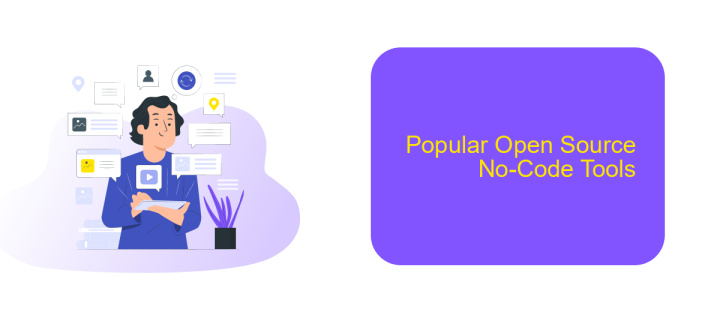No-Code Open Source
No-code open source platforms are revolutionizing the way we approach software development. By enabling users to create applications without writing a single line of code, these tools democratize technology and empower individuals with limited technical skills. This article explores the benefits, challenges, and future potential of no-code open source solutions, highlighting how they are transforming industries and fostering innovation.
Introduction
No-Code Open Source platforms are revolutionizing the way we develop and deploy software applications. By eliminating the need for traditional coding, these platforms empower individuals and organizations to create, customize, and manage applications with ease and efficiency. This democratization of software development is enabling more people to participate in the tech ecosystem, regardless of their technical background.
- Ease of use: Intuitive interfaces make it accessible to non-developers.
- Cost-effective: Reduces the need for expensive development teams.
- Speed: Accelerates the development process significantly.
- Flexibility: Allows for rapid iteration and customization.
- Integration: Seamlessly connects with various services like ApiX-Drive for enhanced functionality.
One of the key benefits of No-Code Open Source platforms is their ability to integrate with other services effortlessly. For example, ApiX-Drive offers a robust solution for setting up integrations with various applications and services, further enhancing the capabilities of your no-code projects. As a result, businesses can streamline their processes, improve productivity, and innovate faster than ever before.
Benefits of Open Source No-Code

Open Source No-Code platforms offer numerous benefits, making them an attractive option for businesses and developers alike. One of the primary advantages is the cost-effectiveness, as these platforms eliminate the need for expensive licenses and reduce dependency on specialized developers. This democratizes software development, allowing individuals with limited technical knowledge to create and deploy applications efficiently. Additionally, the open-source nature ensures continuous improvement and innovation, as a global community of developers collaborates to enhance features and fix bugs.
Another significant benefit is the flexibility and adaptability of Open Source No-Code platforms. Users can customize and extend functionalities according to their specific needs, avoiding the constraints of proprietary software. Integration with other services is also streamlined, thanks to tools like ApiX-Drive, which facilitate seamless connections between various applications. This enhances workflow automation and data synchronization, leading to increased productivity and operational efficiency. Overall, Open Source No-Code platforms empower users by providing accessible, customizable, and cost-effective solutions for their software development needs.
Challenges of Open Source No-Code

Open source no-code platforms offer remarkable flexibility and community-driven innovation, but they also come with their own set of challenges. One of the primary issues is the complexity of integration with other services, which can be daunting for users without technical expertise.
- Security Concerns: Open source projects can be susceptible to vulnerabilities if not regularly updated and monitored.
- Customization Limits: While no-code platforms aim to simplify development, they may lack the depth needed for highly customized applications.
- Dependency on Community: The quality and speed of updates can vary, depending on the community's involvement and expertise.
- Integration Difficulties: Connecting with external APIs and services can be complicated. Tools like ApiX-Drive can help streamline these integrations, but they may not cover all use cases.
Despite these challenges, the benefits of open source no-code platforms, such as cost-efficiency and collaborative development, make them an attractive option. Addressing these issues through robust documentation, active community engagement, and leveraging integration tools can significantly enhance their usability and reliability.
Popular Open Source No-Code Tools

No-code open source tools have revolutionized the way individuals and businesses develop software, enabling anyone to create applications without writing a single line of code. These tools are not only cost-effective but also foster innovation by making technology accessible to a broader audience.
One of the key benefits of using open source no-code tools is the ability to customize and extend functionalities as needed. This flexibility is particularly useful for small businesses and startups that require tailored solutions without the hefty price tags associated with traditional software development.
- Appsmith: A powerful platform for building internal tools quickly.
- Budibase: Allows users to create business apps with ease.
- Directus: An open data platform for managing content across devices.
- ApiX-Drive: Facilitates seamless integration between various applications and services.
These tools not only democratize software development but also enhance productivity by allowing users to focus on their core business activities. Whether you need to automate workflows or create complex applications, open source no-code tools provide the necessary resources to achieve your goals efficiently.


Future of Open Source No-Code
The future of open source no-code platforms is incredibly promising, as they continue to democratize software development and empower individuals without technical expertise to create sophisticated applications. With advancements in AI and machine learning, these platforms are becoming more intuitive and capable, enabling users to build more complex and customized solutions. This trend is expected to accelerate, making technology accessible to a broader audience and fostering innovation across various industries.
Moreover, the integration capabilities of open source no-code platforms are expanding, allowing seamless connectivity between different services and applications. Tools like ApiX-Drive play a crucial role in this evolution by providing easy-to-use interfaces for setting up integrations without coding. This not only enhances productivity but also ensures that businesses can quickly adapt to changing technological landscapes. As a result, the future of open source no-code is set to be a landscape where creativity and efficiency thrive, driven by continuous improvements in integration and user-friendly design.
FAQ
What is No-Code Open Source?
How can No-Code Open Source tools benefit my business?
Are No-Code Open Source tools secure?
Can I integrate No-Code Open Source tools with other software?
What are some common use cases for No-Code Open Source tools?
Do you want to achieve your goals in business, career and life faster and better? Do it with ApiX-Drive – a tool that will remove a significant part of the routine from workflows and free up additional time to achieve your goals. Test the capabilities of Apix-Drive for free – see for yourself the effectiveness of the tool.

